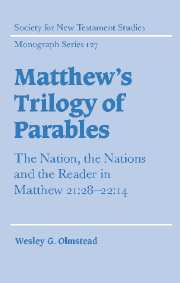Book contents
- Frontmatter
- Contents
- Acknowledgements
- Part one Prolegomena
- Part two The trilogy in narrative-critical perspective
- 3 Jesus' encounter with Israel: the nation, its leaders and their people
- 4 Jesus and the nations: characterisation, plot and the reception of Matthew 21.28–22.14
- 5 A narrative-critical reading of the trilogy
- Part three The trilogy in redaction-critical perspective
- Appendix The text of the parable of The Two Sons
- Notes
- Bibliography
- Index of passages
- Index of selected topics and modern authors
3 - Jesus' encounter with Israel: the nation, its leaders and their people
Published online by Cambridge University Press: 22 September 2009
- Frontmatter
- Contents
- Acknowledgements
- Part one Prolegomena
- Part two The trilogy in narrative-critical perspective
- 3 Jesus' encounter with Israel: the nation, its leaders and their people
- 4 Jesus and the nations: characterisation, plot and the reception of Matthew 21.28–22.14
- 5 A narrative-critical reading of the trilogy
- Part three The trilogy in redaction-critical perspective
- Appendix The text of the parable of The Two Sons
- Notes
- Bibliography
- Index of passages
- Index of selected topics and modern authors
Summary
I suggested in chapter 1 that narrative criticism has a role to play in the rehabilitation of the Synoptic parables both as stories worth examination in their own right (not merely as the necessary starting points for reconstructing Jesus' parables) and as part of the evangelists' wider communicative actions. Part two of this study aims to contribute to this rehabilitation. Chapters 3 and 4 consider the relationship of the parables to the wider narrative, asking both what impact they make upon the developing storyline and, especially, how this wider story influences the reader's reception of the trilogy. Chapter 5 attends to the parables themselves, exploring the ways in which this trilogy addresses its readers.
In this third chapter, we turn our attention to the narrative's portrait of Israel for the following reasons. First, the trilogy is set in the midst of Jesus' escalating conflict with the Jewish establishment. Second, Jesus addresses each of these parables to the Jewish leaders. Third, The Tenants rehearses the story of Jesus' reception in Israel. Fourth, following both The Two Sons and The Tenants, the Jewish people are distinguished from their leaders. Fifth, from the earliest scenes, Jesus' encounter with Israel is seldom far from centre stage in the dramatic story that Matthew tells. Indeed, at one level, Matthew's narrative is the story of Jesus' encounter with Israel. Sixth, this story is already well advanced before the reader meets this trilogy of parables.
- Type
- Chapter
- Information
- Matthew's Trilogy of ParablesThe Nation, the Nations and the Reader in Matthew 21:28-22:14, pp. 49 - 70Publisher: Cambridge University PressPrint publication year: 2003



